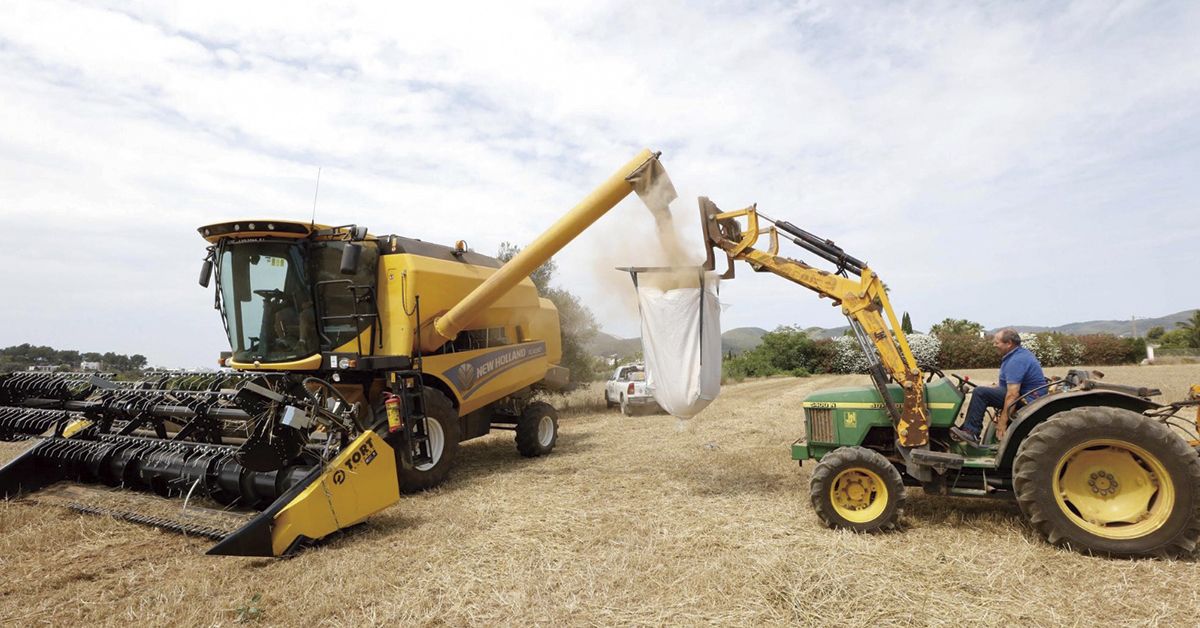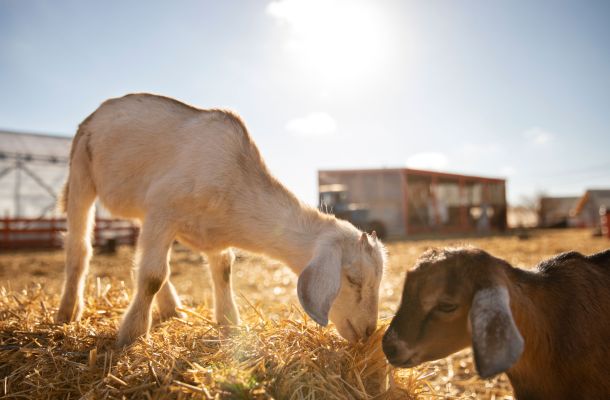A joystick for harvesting in Ibiza


Juan Tur looks like a kid in new shoes. On the Can Calbet estate, almost next to the Santa Eulària road (next to Eivissgarden), he poses next to the brand new New Holland TC 4.90 combine harvester that the Sant Antoni Cooperative has just bought for 250,000 euros. He is delighted with this expensive toy. For everything, for its 2.4 metres of folding and 4.8 metres of work, for its speed and power and, above all, because the cab has air conditioning and a fridge, which is appreciated when, like yesterday, it gets up to 31 degrees at midday: "Do you want a bottle of cold water?
Tur has to mow a hectare of wheat at Can Calbet, a crop belonging to Vicent Sala, who will use the grain to feed his chickens. Sala has a chicken rotisserie. This year, the wheat "hasn't been good. Some of it is half-done, it's gone to seed," he explains. Before threshing, he waits until 11 o'clock, which is when the plant has lost the moisture that has fallen during the night. To find out, he picks up an ear of corn and crumbles it with his hands: if the grain separates cleanly from the rest, he can bring the combine into the field. If not, "have a beer and wait".
In 10 minutes, he calculates, he will have completed the harvesting of the first plot, which was left half-finished on Sunday because the machine's silo, with a capacity of 1,500 kilos (or two cubic metres), was full. To empty it, he needs the help of Sala, who arrives with an old John Deere tractor to which he attaches a sack. They filled four in just 10 minutes.
And what was Tur doing on Sunday at Can Calbet? Practising. He is a novice at operating the New Holland TC 4.90: he had never been at the controls of a combine harvester before. He took advantage of the public holiday to gain confidence and get to know the machine in depth: "It's better on a Sunday, so that nobody sees me if I do something stupid", he says with a laugh.
Tur, head of the Cooperative's machinery section (he was its president for nine years), has been using tractors and other types of agricultural machinery "all his life" (three decades). In fact, he says that the TC 4.90 is "very intuitive to operate", using a joystick, as if it were a video game, for the main functions. To empty the silo of the combine, for example, he only has to press one button: with the Cooperative's two older John Deere machines, the process was more complicated and required more physical effort, he explains.
Although he is a novice, the company's technicians gave him a three-day intensive course in Lleida and he can ask them any questions, such as the loss of oil that he suffered just this morning. All he had to do was send them a video and they explained to him how to fix it.
Technology is a pleasure
The difference with the old machines is huge. It looks like a NASA device: the New Holland even warns him if he is breaking the grain when threshing: "It's nice how technology helps you". Thanks to the fact that this year's rains have delayed the harvest, there is still "40% of cereals to be harvested", he explains, enough to get to know it in depth this year: "We are well behind schedule, about a month". And also for tests: on a farm located between Sant Llorenç and Santa Eulària they will check whether, in addition to wheat or oats, they can thresh mustard.
A huge cloud of dust appears when the sacks are filled with the grain accumulated in the silo. It is the earth that the machine collects when threshing, a consequence of the ground being full of unevenness and furrows. If you put your hand in the sack of grain, it comes out full of brown earth dust. Tur says that this does not happen in Lleida, where they flatten the ground with a roller before sowing. He wants to propose this practice in Ibiza to improve the yield and, incidentally, to prevent the tines of the harvester from breaking when dragging so much earth or hitting the stones: "The better the soil, the fewer breakdowns".
Lack of respect on the road
So far, the only thing that bothers him about using it is the treatment he has received on the road every time he moves the New Holland from farm to farm: "Everyone eats bread, everyone uses wheat flour on occasion, but when I drive the harvester I only receive insults from people who have no patience and don't understand that this machine has a limited speed". Specifically, 30 kilometres per hour. "I only ask for respect. The harvest only lasts a month. In Catalonia, for example, this doesn't happen: if they see you with the harvester, they pull over to the side of the road and wait. It's a shame what happens here.
He thought he would do it in 10 minutes, but it takes him half that time. As it passes, the harvester deposits a linear pile of straw. The owner uses the straw, after baling it, "as bedding for the cattle". But there is another option, Tur says: he can activate the machine's chopper and spread the remains on the ground, which is a way of incorporating nutrients. "Our old harvesters don't do that.
At night in Lleida
"When I told people in Lleida how we work with the harvester, they would lower their heads", Tur explains. There, he explains, there are not so many difficulties in accessing the land, nor is it so uneven. He was fascinated by what he saw there: for example, four machines bigger than his own (with 14 metres of cut, a dozen more than the Cooperative's) harvesting in parallel at night, "because the dew doesn't fall there". "It's hard to see that. Here everything is smaller".
Cover image: J. A. Riera
Source: Diario de Ibiza








